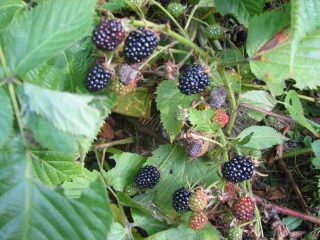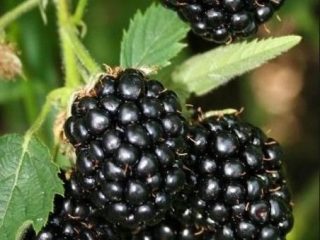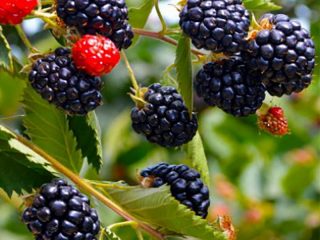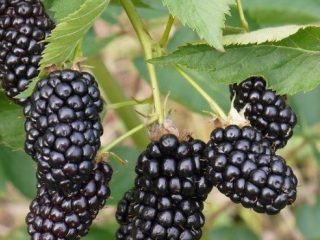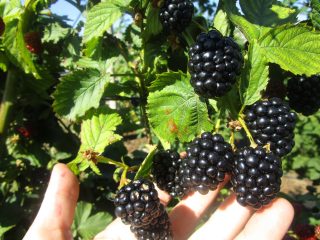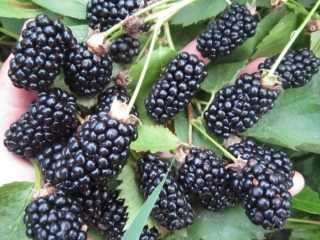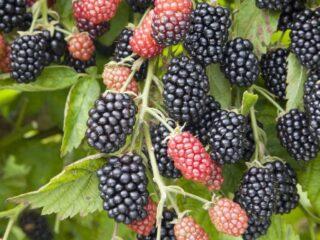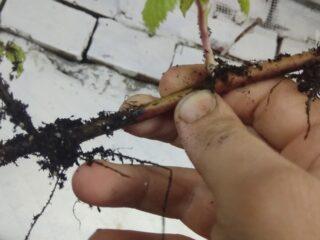Content
At first glance, blackberries and black raspberries look very similar. This is not surprising, because both plants belong to the same family - Pink. However, to the eye of a botanist, the difference between black raspberries and blackberries is obvious. The appearance of the bushes, the taste of the berries vary, and there are other nuances that make it possible to accurately “identify” the crops.
What are black raspberries and blackberries?
Blackberries are a “natural” plant found everywhere in the Northern Hemisphere. It is especially common in Northwestern and Central Europe. The vast majority of its varieties and hybrids are bred on the basis of two species - gray and bushy. Actually, only the first is sometimes called “blackberry”, the second is called “bramberry”.
In contrast, black raspberries do not occur in nature. This is a selectively bred hybrid of classic red raspberries and blackberries, as directly indicated by the second name of the crop - “ezhemalina”. The first such hybrid appeared at the end of the 19th century in the USA. Its main differences between the “parent”, in addition to the color of the berries, are higher yield and overall endurance, “stress resistance”.
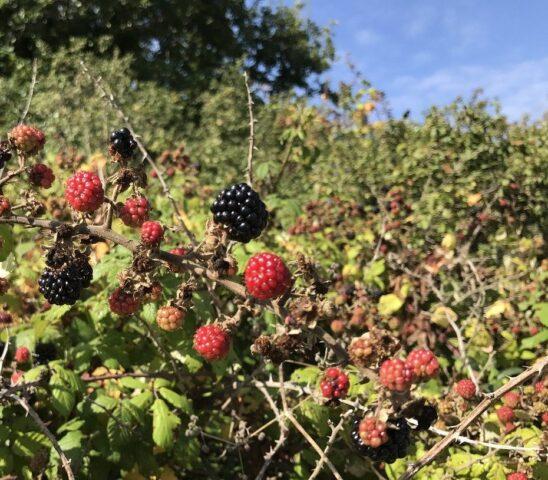
Unlike blackberries, blackberries are bred artificially.
What is the difference between blackberries and black raspberries?
The differences between blackberries and raspberries are much greater than the similarities. “Commonality”, in fact, is limited only by belonging to the same family and the color of the berries. But even in “darkness” there is a difference in shades.
Bush shape and leaves
Both crops are bushes with shoots growing directly from the ground. But blackberries look more “powerful”.
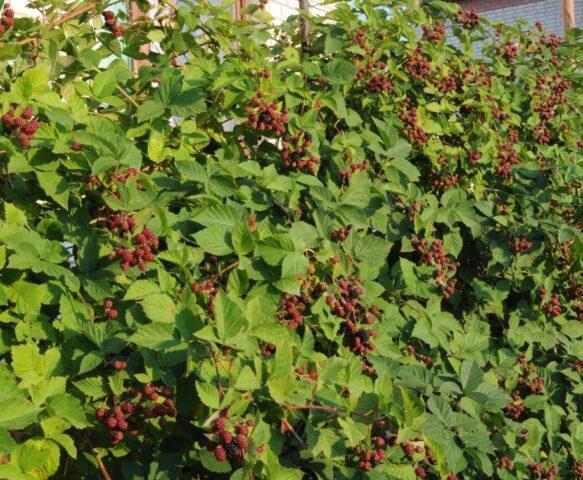
Unpruned blackberry bushes resemble a solid “wall”
To distinguish a black raspberry bush from a blackberry, you need to consider:
- Plant height. Here, a lot depends on the variety, but chokeberry shoots rarely stretch more than 1.8-2 m. For blackberry bushes, the average norm is 2.5-3 m.
- Features of shoot growth. Many varieties of black raspberries can do without a garter; their branches are erect, almost not bending under the weight of the berries. In contrast, blackberry bushes have shoots that are often drooping and arched; they definitely need support, otherwise they creep along the ground.
- Shoot color. In Ezhmalina they are brown, sometimes with a reddish tint, covered with a thin layer of bluish or lilac-gray “patina” that can be wiped off with a finger. In contrast, the shoots of blackberry bushes are dark green.
- General form. Blackberry bushes grow more actively than black raspberries, so they are denser. Without pruning, they quickly turn into impenetrable thickets. Chokeberry raspberries, in contrast, look “neater”; the bushes are relatively sparse.
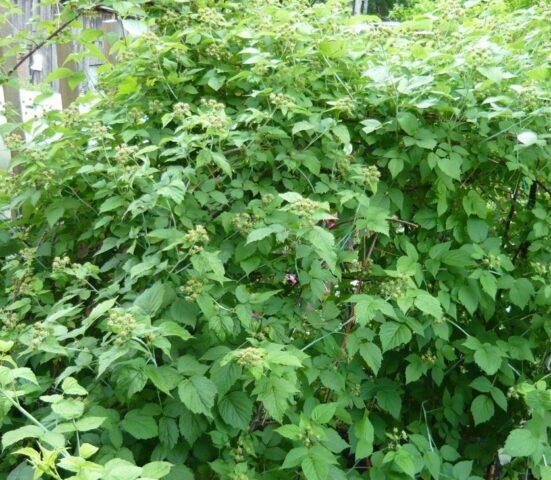
The raspberry bush looks “miniature” in comparison with the blackberry bush.
It is difficult for a non-specialist in botany to distinguish black raspberries from blackberries by the shape of their leaves. The second one has them a little larger, but the shape is almost identical. But raspberries have densely leafy shoots.
Appearance of fruits
If you put two berries next to each other, the difference immediately catches your eye - chokeberry raspberries are noticeably smaller, they are round in shape, reminiscent of a hemisphere. Many varieties have a slightly “hairy” surface. The blackberry is elongated, looking like a cross between a cone and a cylinder.
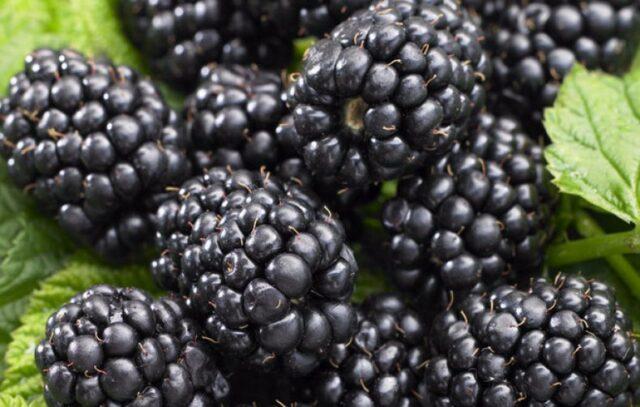
Most often, the skin of blackberries is covered with a thin layer of bluish coating.
Both berries consist of interlocking spherical drupes. But in blackberries they form around a “kernel” that is part of the fruit. When harvesting, only the peduncle remains on the branch. In contrast, the raspberry is easily separated from the white receptacle; the berry is hollow inside.
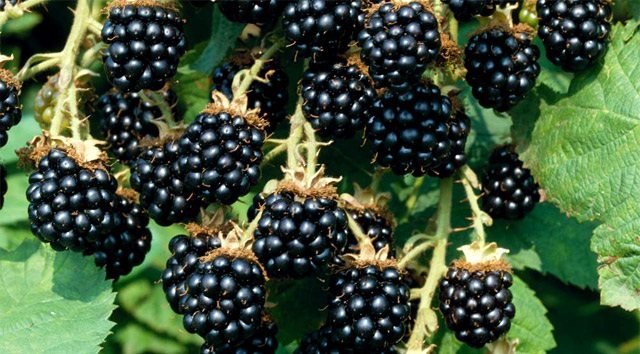
The difference between black raspberries, noticeable even to a non-specialist, is the smaller size of the berries.
Taste of berries
Any raspberry is characterized by a distinctly sweet taste, sometimes with a slight balancing sourness. Some even consider it too “boring” and “bland”.
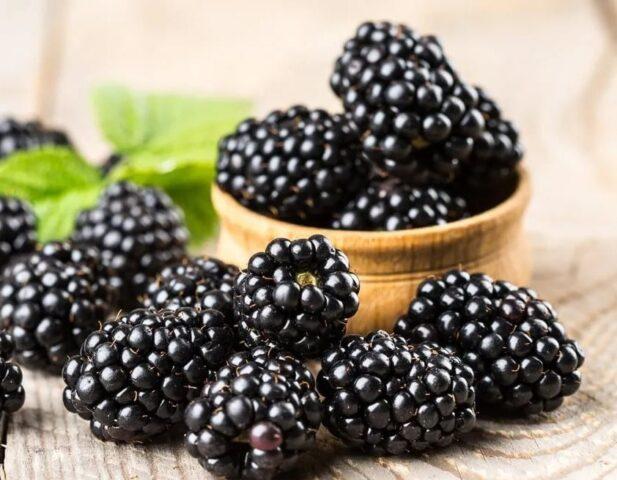
The blackberry flavor will surely appeal to those who prefer unsweetened berries - blueberries, blueberries
One of the main differences between black raspberries and blackberries: the latter cannot be called sugary. It is characterized by a refreshing sweet and sour taste; some varieties also have a pronounced tart-spicy aftertaste.
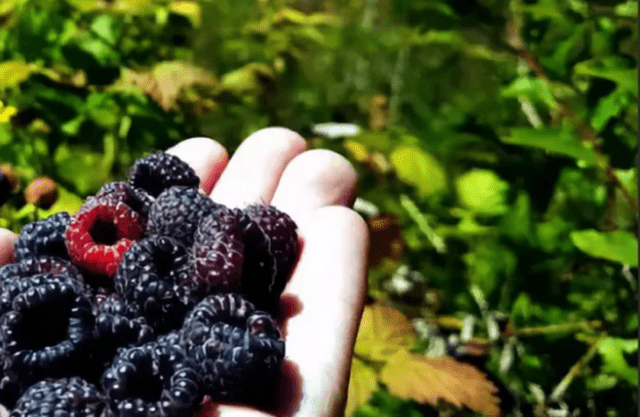
The sweetness of black raspberries may even seem overpowering.
In terms of juiciness and consistency, there is no difference between “classic” raspberries and everyday raspberries. When bitten, blackberries combine softness with a certain “crunchiness”.
Fruiting
When comparing black raspberries and blackberries in terms of yield, the latter definitely wins.For modern varieties and hybrids of raspberry, the average is 4-5 kg per plant per season. In blackberry bushes it reaches 18-20 kg. The weight of one berry in the first crop is 2-5 g, in the second – 8-10 g.
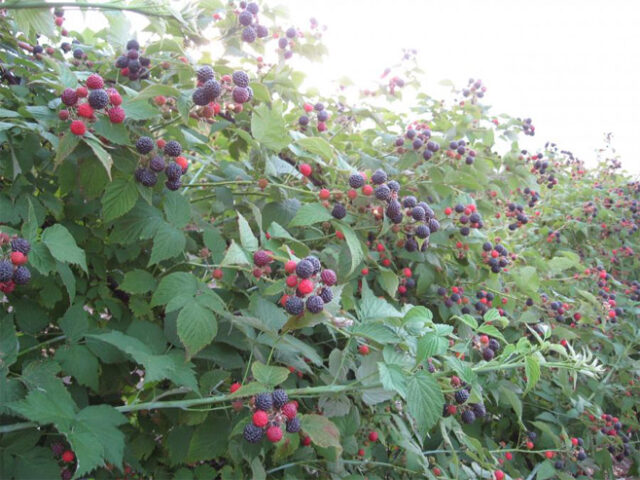
The productivity of blackberry bushes is several times higher than that of blackberry bushes
Presence of thorns
Black raspberries “inherited” their thorns from ordinary red ones without any differences. They are thick, but quite short and thin, not too sharp, and from a distance they resemble “pile”.
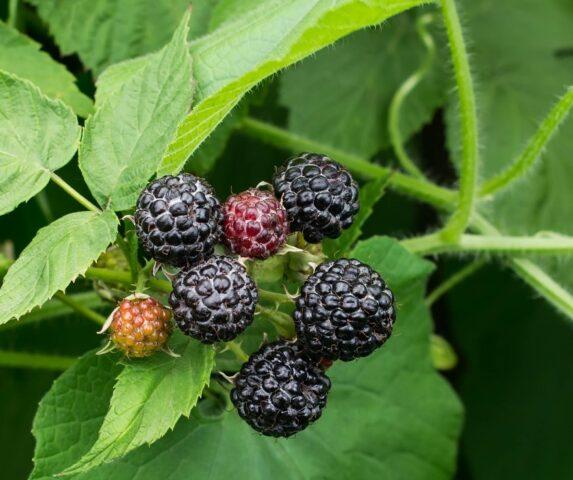
It is difficult to prick yourself strongly with black raspberry thorns
Blackberry thickets are impenetrable thanks not only to the dense shoots, but also to the thorns on them. They are long (up to 1 cm), hard, sharp, with a curved end, and are not located too often on branches. There are practically no differences from the thorns on the stems of roses.
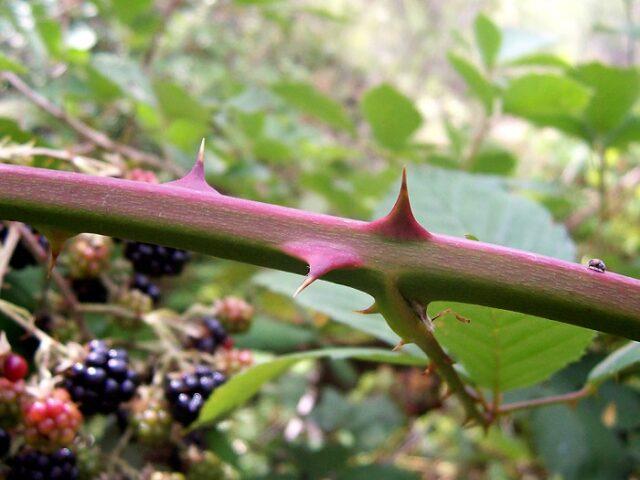
Trying to “cut through” wild bushes that resemble a “tangle” of barbed wire, you can get quite serious abrasions
Ripening time
Wild blackberries bear fruit starting in the second ten days of July for 4-6 weeks. “Cultivated” varieties and hybrids “inherited” an extended fruiting period, but there are significant differences in the timing of berry ripening. Breeders have created both early-ripening varieties, which ripen already in the second ten days of June, and late varieties, in which fruiting occurs at the end of August-September.
Natural raspberries ripen 2-3 weeks earlier. Dark-fruited varieties and hybrids have retained this feature. Unlike blackberries, the black raspberry crop ripens more “en masse.” The berries are harvested within 2-3 weeks. The timing of fruiting also depends on the variety - early, mid and late ripening varieties are bred.
This difference is explained by the longer growing season of blackberries. Even the earliest varieties take about six weeks to ripen the berries; for late-ripening varieties, this period increases by another 15-20 days. Every spring “wakes up” earlier, so the crop ripens faster.
Care requirements
Ezhemalina and blackberries do not tolerate “neighborhood”. The bushes “transmit” diseases to each other, pests spread faster throughout the plantings, causing more damage to them. Also unsuitable “companions” for both crops are other Pink and Solanaceae - there are no differences between them.
Both blackberries and black raspberries are moisture-loving, but the former will tolerate short-term “drought” better. But the second one can develop normally and bear fruit not only in light “openwork” partial shade, but also in fairly dense shade. Of course, the volume and quality of the harvest decreases, but the berries still ripen. In contrast, when there is a lack of light, blackberries practically stop growing; very few fruit ovaries are formed, or they are not formed at all.
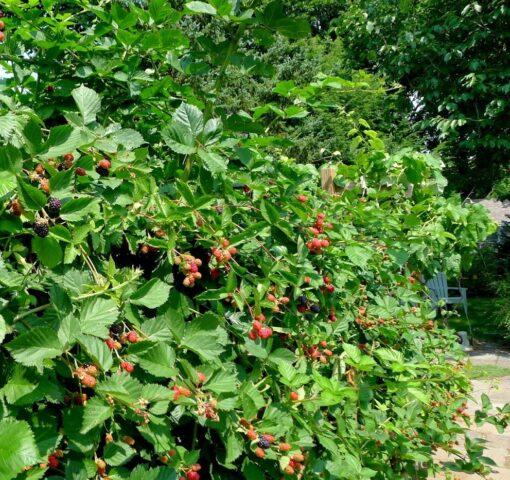
Blackberries have nothing against direct sunlight, but blackberries quickly “cook” in such conditions and the leaves lose their tone
Differences in cold tolerance of crops vary markedly depending on the variety, but on average, black raspberries have higher cold tolerance than blackberries. It can withstand temperatures down to -25°C without damage or with minimal damage. For “cultivated” varieties and hybrids of the second berry, the critical minimum is about -15 °C.In more severe frosts, it suffers greatly even with careful shelter. This is its difference from wild blackberries, which are more cold-resistant (down to -25-30 ° C).
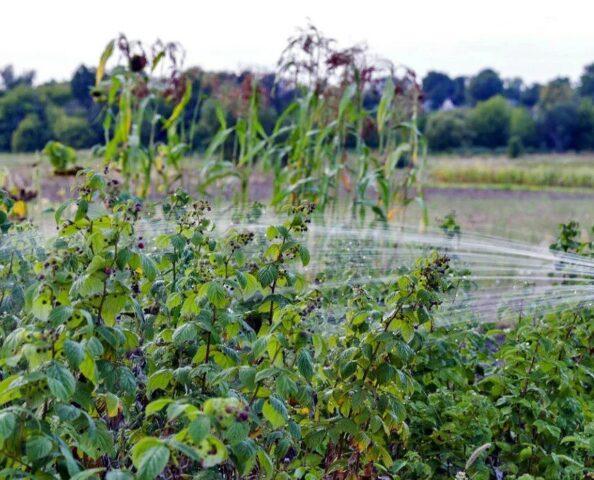
Regular watering is more important for black raspberry bushes than for blackberry bushes
Both crops do not tolerate stagnation of moisture in the soil and react by rotting roots to groundwater that comes close to the surface of the earth. But loam is ideal for blackberries; black raspberries, in contrast, prefer lighter sandy loam or forest gray soil.
Resistance to diseases and pests
In terms of resistance to pathogenic microflora and insects, there are practically no differences between black raspberries and blackberries. Since both crops belong to the same family, the same diseases and pests are typical for them.
Blackberries are more hardy than raspberries, but it all depends on the specific characteristics of the variety or hybrid. Some have “innate” immunity to certain fungi, they are “bypassed” by certain insects, but you cannot do without preventive treatments with fungicides and insecticides when growing both blackberries and black raspberries.
Conclusion
The “basic” difference between blackberries and black raspberries is the origin of the crops. The first is “bred” by nature itself, the second is a selection hybrid, not found in natural conditions.It is impossible to confuse them, even with a superficial acquaintance with both crops - both the general appearance of the bushes and the taste of the berries are different, and there are important nuances when it comes to agricultural technology.
